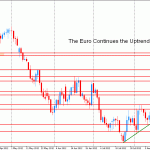Euro Gains +245 Pips on ECB Bond Buying Plan And Levels to Watch Next Week September 10th 2012

Last week in the forex market was all about the ECB. On September 6, the new ECB bond buying program was supposed to be unveiled. But since secrecy seems to be non-existent in Europe's politics we got the plan leaked early just like it happened countless times before. On September 5 the ECB sent the plan to the Central Banks of the individual countries and that was enough to get the whole thing leaked and published on Bloomberg. Since the leaked plan didn't differ much from what actually happened, I'll just talk about the actual announcement not the leak so as to not repeat myself.
The ECB's newest bond buying plan is called OMT (Outright Monetary Transactions). It will replace the Securities Markets Program (SMP), the ECB's current bond buying program which has been inactive for over 25 weeks now. The main difference between the two programs seems to be that this time the ECB has committed to what it called “unlimited” purchases. The purchases will be sterilized not outright Quantitative Easing (QE) program, meaning the Central Bank will try to suck up the money it prints by offering weekly interest rate deposits to banks.
But the fact that the bond buying will be sterilized puts the whole “unlimited purchases” in doubt because it may be restricted by how much liquidity the Bank can suck up from the system. Of course it is always possible that the ECB will turn this program into outright QE if the market conditions don't allow it to suck up liquidity. The ECB has renegaded on previous statements/promises, the most famous case of this was when the its previous President Jean-Claude Trichet famously said that the Bank will not engage in bond purchases only to do exactly that just few days later by buying Greek Bonds.
An important elements of the OMT is conditionality, another thing that makes it different from its predecessor the SMP. The ECB will only act after a sovereign has asked for aid from either the EFSF or the ESM, European's bailout funds. The IMF will also be called in and asked to engage in monitoring of the aid recipient country. Under the new program, the ECB may stop buying bonds or even sell bonds if a country fails to meet the agreed conditions.
The Central bank will only buy bonds on the secondary market, leaving Europe's bailout funds with the job to act in the primary market. And finally the ECB will only buy bonds with “maturities of one to three years, including longer-dated debt that has a residual maturity of that length”.
The reaction to the leaked plan on Wednesday was a Euro rally, the EUR/USD gained over 70 pips on the news. By Thursday and the scheduled time for the ECB press conference most of the details were already known and digested so the Euro only gained 10 pips versus the dollar in the aftermath of the conference. But the pair suddenly decided to continue the rally on Friday, gaining 82 pips before the release of the important U.S. Jobs report.
The NFP report came in worse then expected. The U.S. Economy only added 96,000 jobs in August compared to expectations for a gain of 123,000. July's number was revised down from 163,000 to 143,000. This triggered a broad U.S. Dollar weakness allowing the Euro to rally some more. The EUR/USD gained 101 pips in the aftermath of the bad jobs data, bringing the total for the week to +245 pips, a stellar performance for the single currency.
The pair closed the week at 1.2814. The levels to watch out for next week include 1.2823, just few pips to the upside from where the pair closed, followed by the 1.2974 – 1.3000 area. This area has acted as a very strong support area in the past, in the chart below you can see the 3 previous times in February, March and April when this area was tested but help up, so it will probably act as a strong resistance to any moves up.
To the downside, 1.2750 will provide some support, followed by 1.27. If that level breaks, the 1.2550 – 1.2588 area together with the current upward trendline in the Euro at 1.2511 will provide support. Below that 1.2450 and 1.24 may act as support, followed by 1.2234 and then by 1.2161. The last level seen on the chart is at 1.2041, the swing low from where the latest big rally in the Euro started from.


